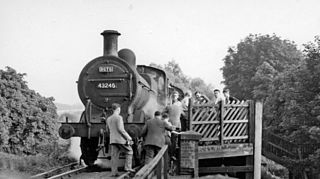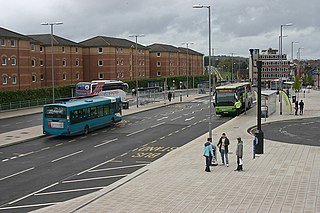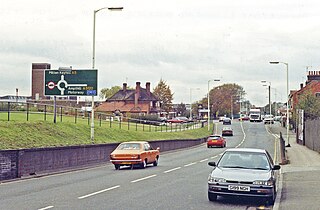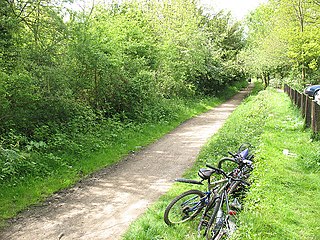BBC Three Counties Radio is the BBC's local radio station serving the counties of Bedfordshire, Hertfordshire and Buckinghamshire.

The Nickey line is a disused railway that once linked the towns of Hemel Hempstead and, initially, Luton but later Harpenden via Redbourn, in Hertfordshire, England. The course of most of the railway has been redeveloped as a cycle and walking path, and is part of the Oxford to Welwyn Garden City route of the National Cycle Network. It is approximately nine miles (14 km) long.

Leighton Buzzard railway station serves the towns of Leighton Buzzard and Linslade in the county of Bedfordshire and nearby areas of Buckinghamshire. Actually situated in Linslade, the station is 40 miles (64 km) north west of London Euston and is served by London Northwestern Railway services on the West Coast Main Line. Until the 1960s the station was the start of a branch to Dunstable and Luton, with a junction just north of the present station. The station has four platforms. Platforms 1 & 2 serve the fast lines and are used by Avanti West Coast services running non-stop to/from London Euston. Platforms 3 & 4 are served by slower London Northwestern railway services to/from London Euston.

Luton railway station is located in the town centre of Luton, Bedfordshire, England. The station is about three minutes' walk from The Mall Shopping Centre. It is situated on the Midland Main Line and is operated by Thameslink.

Welwyn Garden City railway station serves the town of Welwyn Garden City in Hertfordshire, England. It is 20 miles 25 chains from London King's Cross on the East Coast Main Line. Train services are currently provided by Thameslink and Great Northern.

Dunstable Town, also known as Dunstable Church Street, was a railway station on the Great Northern Railway's branch line from Welwyn which served Dunstable in Bedfordshire from 1858 to 1965. Against a background of falling passenger numbers and declining freight returns, the station closed to passengers in 1965 and to goods in 1964, a casualty of the Beeching Axe. The station site is now in use as part of the Luton to Dunstable Busway.
Harpenden East was one of two stations serving the town of Harpenden, the other station which remains open being Harpenden Central. Originally named Harpenden, the East suffix was added in 1950 to distinguish it from the Midland Railway station.

Chiltern Green railway station was built by the Midland Railway in 1868 on its extension to St. Pancras.

Luton Bute Street railway station was the first to be built in Luton, England. It was opened by the Luton, Dunstable and Welwyn Junction Railway Company in 1858, which was an extension of the Welwyn and Hertford Railway. The track to Welwyn was completed in 1860 and taken over by the Great Northern the following year.

Luton is a town in the United Kingdom less than 30 miles (50 km) north of the centre of London, and has good transport links via the motorway network and the National Rail system. Luton is also home to Luton Airport, one of the major feeder airports for London and the southeast. The town is also served by buses run by Arriva Herts & Essex and other operators and has a guided busway. As a Unitary Authority, Luton Borough Council is responsible for local highways and public transport in the borough.

Luton Hoo railway station was built by the Hertford, Luton & Dunstable Railway on the branch line between Hatfield and Dunstable. It opened in 1860 and was originally called New Mill End. In 1861 the railway was taken over by the Great Northern Railway. The name changed to Luton Hoo in 1891 and the station closed in 1965. The last passenger train, packed with enthusiasts, was hauled by Brush Type 2 D5589 on 24 April 1965.
Stanbridgeford railway station on the London and North Western Railway's branch line to Dunstable served the Bedfordshire villages of Stanbridge, Totternhoe, Eaton Bray and Tilsworth from 1849 to 1964. Once popular with visitors to the nearby Totternhoe Knolls and ramblers, the station closed against a background of falling passenger numbers and declining freight returns. The station building has survived into private ownership, but a section of the alignment to the east and west of the site has been taken into the A505 Leighton Southern Bypass. National Cycle Network route 6 runs to the east over the bypass as far as the outskirts of Dunstable.

Dunstable North was a railway station on the London and North Western Railway's branch line from Leighton Buzzard which served Dunstable in Bedfordshire from 1848 to 1967. Originally the terminus of the London and North Western Railway's branch line from Leighton Buzzard, Dunstable became the point where the line met with the Great Northern's branch line from Luton in 1858. The station became the hub of a number of sidings connecting a variety of concerns to the line, including Waterlows, Bedfordshire County Council, Associated Portland Cement, Dunstable gasworks and a coal yard operated by the Great Northern. Against a background of falling passenger numbers and declining freight returns, the station closed to passengers in 1965 and to goods in 1967. Connections were retained with the cement works and coal yard, which became an oil depot, until 1988 and the line eventually closed in 1991. The site of the station is now occupied by offices of Central Bedfordshire Council. A section of the former line to the west of the site has become part of route 6 of the National Cycle Network.

Wheathampstead railway station was a railway station serving Wheathampstead on the Great Northern Railway branch line to Dunstable. While little of it remains now, east of Wheathampstead is the Ayot Greenway which follows what was the line towards Welwyn Garden City.

The Ayot Greenway is a rail trail which extends from Ayot St Peter, just west of Welwyn Garden City and the A1(M) Motorway to Wheathampstead in Hertfordshire. Part of National Cycle Network Route 57, it runs for three miles along a former branch line from Welwyn Garden City railway station towards Luton and Dunstable.

The Cole Green Way is a rail trail which runs east-west from the eastern edge of Welwyn Garden City to Hertford in Hertfordshire. Part of National Cycle Network Route 61, and the Lea Valley Walk, it runs for more than six miles along the former Hertford, Luton & Dunstable branch line from Welwyn Garden City railway station to Hertford North railway station.

National Cycle Route 57 is part of the United Kingdom's National Cycle Network. When complete, it will run west to east from Farmington, Gloucestershire near Northleach to Welwyn Garden City in Hertfordshire.

Chaul End was a temporary railway halt on the Great Northern Railway's branch line from Welwyn which served a munitions factory near Luton during the First World War. The station site has been reused as part of the Luton to Dunstable Busway.

The Luton-Dunstable Busway is a guided busway system in Bedfordshire, England, which connects the towns of Dunstable, Houghton Regis and Luton with Luton Airport. It was built on the route of a disused railway track and opened in September 2013. The busway runs parallel to the A505 and A5065 for 13.4 kilometres (8.3 mi), of which 7.7 kilometres (4.8 mi) is guided track with a maximum speed of 50 mph. It is claimed to be the second longest busway in the world.
The Hertford, Luton and Dunstable Railway was a railway affiliated to the Great Northern Railway. It was formed when the Hertford and Welwyn Junction Railway merged with the Luton, Dunstable and Welwyn Junction Railway, partly opened in the same year. The merger and change of title took place in 1860. The line joined the Dunstable branch of the London and North Western Railway at Dunstable.



















